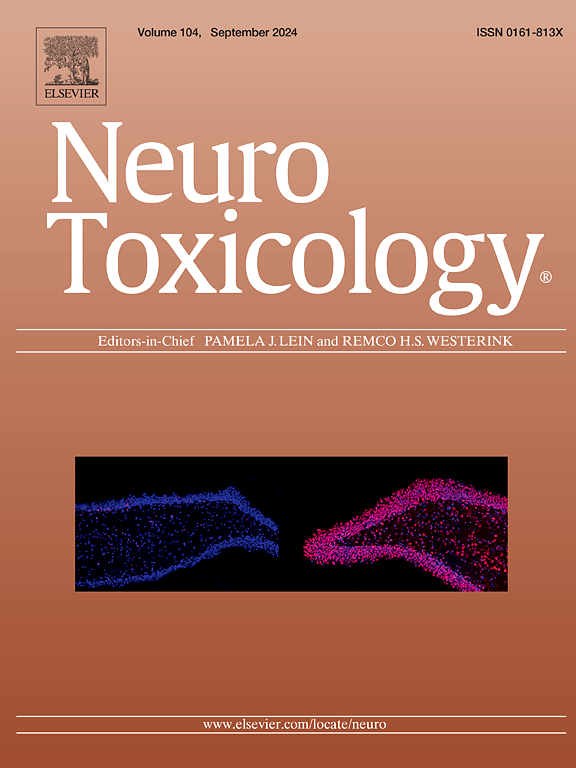PRDX1 affects acrylamide-induced neural damage through the PTEN/AKT signaling pathway
IF 3.9
3区 医学
Q2 NEUROSCIENCES
引用次数: 0
Abstract
Peroxiredoxin 1 (PRDX1) is a member of the peroxidase family of antioxidant enzymes. However, the role and mechanism of PRDX1 in acrylamide (ACR)-induced nerve damage have not been reported. We used SD rats and well-differentiated rat pheochromocytoma cells (PC-12 cells) to established in vivo and in vitro models of ACR. Immunohistochemistry, immunofluorescence and RT-qPCR experiments were used to detect the expression of PRDX1 in neurons of rat hippocampal tissue. The ultrastructural changes of neurons and PC-12 cells in rat hippocampal tissue were observed under transmission electron microscope. Western blot detected the protein expression levels of PRDX1, PTEN, AKT and p-AKT. In vivo and in vitro experimental results showed that PRDX1 showed a significant up-regulation trend after ACR exposure (p < 0.05). In vitro experiments showed that after inhibiting PRDX1 expression with PRDX1 siRNA, the survival rate of PC-12 cells significantly increased, and the damage to cell morphology and organelles was markedly improved. Western blot analysis revealed that ACR exposure can cause a significant increase in PTEN protein expression level and p-AKT/AKT protein ratio (p < 0.05). After inhibiting the expression of PRDX1, the protein expression level of PTEN and the protein ratio of p-AKT/AKT were significantly reduced, while the protein levels of SYN1 and BDNF were significantly increased (p < 0.05). This study, for the first time, demonstrates that PRDX1 affects ACR-induced neurotoxicity by regulating the PTEN/AKT signaling pathway. And, provides novel insights into the prevention and treatment of neurotoxicity in populations exposed to ACR.
PRDX1通过PTEN/AKT信号通路影响丙烯酰胺诱导的神经损伤
过氧化物还氧蛋白1 (PRDX1)是过氧化物酶家族中的一员。然而,PRDX1在丙烯酰胺(ACR)诱导的神经损伤中的作用和机制尚未见报道。我们用SD大鼠和分化良好的大鼠嗜铬细胞瘤细胞(PC-12细胞)建立了体内和体外ACR模型。采用免疫组织化学、免疫荧光和RT-qPCR检测PRDX1在大鼠海马组织神经元中的表达。透射电镜下观察大鼠海马组织神经元和PC-12细胞超微结构的变化。Western blot检测PRDX1、PTEN、AKT、p-AKT蛋白表达水平。体内和体外实验结果显示,ACR暴露后PRDX1呈显著上调趋势(p <; 0.05)。体外实验表明,用PRDX1 siRNA抑制PRDX1表达后,PC-12细胞存活率显著提高,对细胞形态和细胞器的损伤明显改善。Western blot分析显示,ACR暴露可导致PTEN蛋白表达水平和p-AKT/AKT蛋白比值显著升高(p <; 0.05)。抑制PRDX1表达后,PTEN蛋白表达水平和p-AKT/AKT蛋白比值显著降低,而SYN1、BDNF蛋白表达水平显著升高(p <; 0.05)。本研究首次证实PRDX1通过调控PTEN/AKT信号通路影响acr诱导的神经毒性。并且,为ACR暴露人群的神经毒性的预防和治疗提供了新的见解。
本文章由计算机程序翻译,如有差异,请以英文原文为准。
求助全文
约1分钟内获得全文
求助全文
来源期刊

Neurotoxicology
医学-毒理学
CiteScore
6.80
自引率
5.90%
发文量
161
审稿时长
70 days
期刊介绍:
NeuroToxicology specializes in publishing the best peer-reviewed original research papers dealing with the effects of toxic substances on the nervous system of humans and experimental animals of all ages. The Journal emphasizes papers dealing with the neurotoxic effects of environmentally significant chemical hazards, manufactured drugs and naturally occurring compounds.
 求助内容:
求助内容: 应助结果提醒方式:
应助结果提醒方式:


